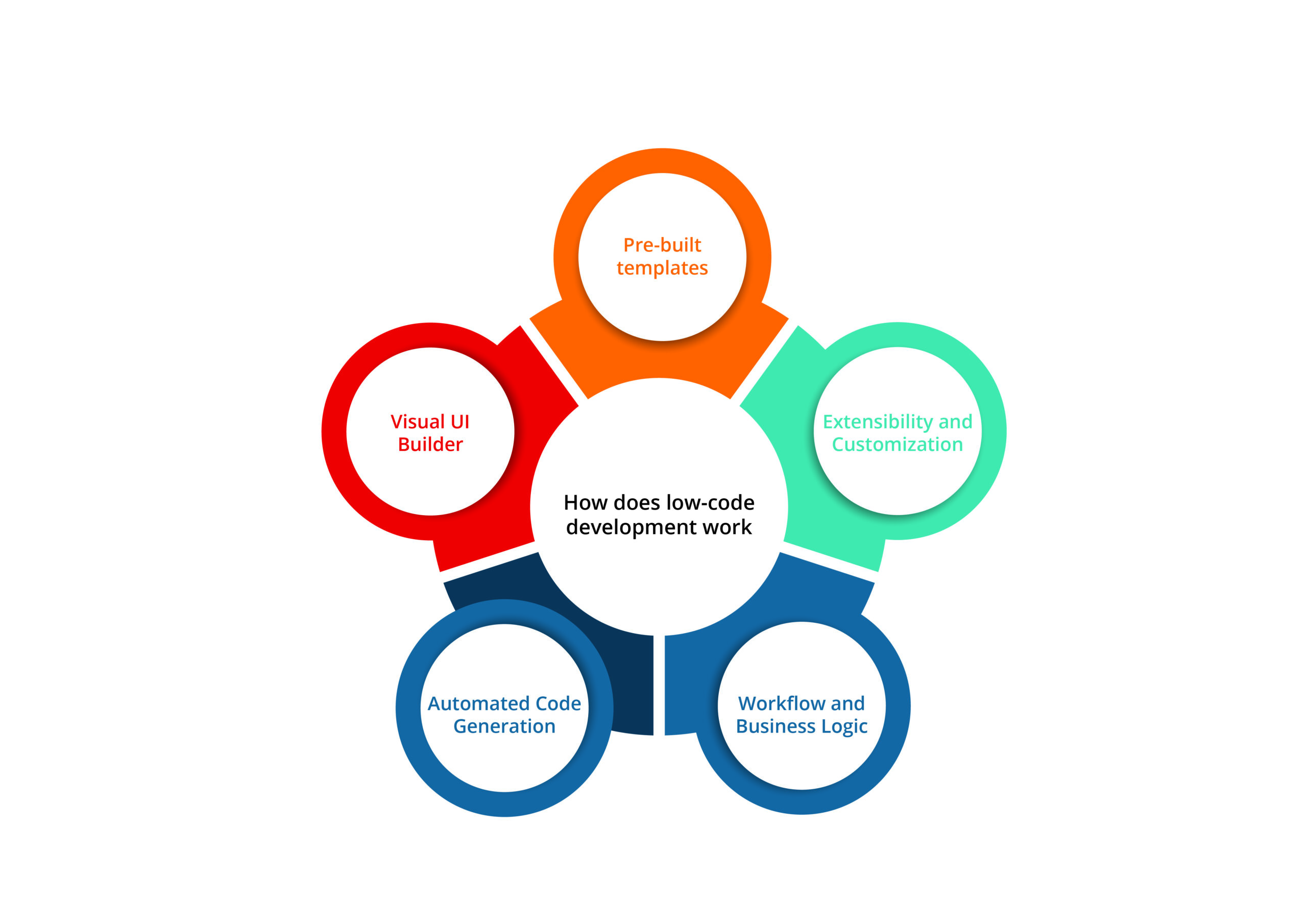
For decades, businesses had only two options when it came to application development – either buy ready-made applications from an external vendor or build from scratch with skilled developers. But packaged software is far from perfect. What if you encounter a unique situation that the readymade software can’t handle? Off-the-shelf applications may only fit some of your needs, leaving gaps in your operations. On the other hand, building applications with an in-house team can be expensive and time-consuming.
This is where low-code development comes in! It makes the app creation process easier by bringing the power of app development to anyone in your business. The global low-code platform market is forecasted to generate a revenue of $187 billion by 2030, increasing from $10.3 billion in 2019. The impact of this technology is undeniable. In this article, we will discuss more about low code application development and how it is revolutionising the way software applications are built.
What is low-code application development?
Low code application development is a way to build applications using drag-and-drop functionality and visual guidance—with very little or no coding knowledge. The best part here is people who don’t have extensive technical knowledge can quickly and efficiently build applications on low-code platforms. These platforms provide visual UI Builders, ready-made code snippets, and pre-built templates for forms and reports, making app development fast and easy. Think of it as building with Lego, effortlessly combining the pieces to create various structures.
This not only saves time, making companies more efficient and productive. It also enables you to prioritize apps that demand the most attention, such as customer experience apps and those automating vital business processes.
How does low-code development work
The traditional app development process demands a complex development environment, rigorous testing, and precise deployment protocols. It entirely relies on a highly skilled team of programmers, developers, testers, and more. In contrast, low-code application development platforms offer a visual programming approach that facilitates automatic code generation.
Here’s a more detailed explanation of low-code features that accelerates the development process –

Visual UI Builder
The visual development environment of low-code platforms enables users to design and develop applications using drag-and-drop components. This feature greatly enhances the production process, supporting both citizen and technical developers to see how the app will look while they are building it.
Pre-built templates
Low-code platforms offer a collection of ready-to-use templates, which serve as a starting point for application development. These templates include pre-designed layouts, buttons, input fields, data grids, charts, and more. They’re like the building blocks you can easily arrange. This accelerates the development process and ensures a consistent design approach.
Workflow and Business Logic
Users can define the application’s logic and workflow using visual tools, often in the form of flowcharts or diagrams. These visual representations of the application’s logic are translated into the underlying code by the low-code platform. The workflow determines how the application processes data, execute actions based on user interactions, and handles business rules. This streamline processes and ensures that your business rules are consistently applied, all without manual coding.
Automated Code Generation
As users design the application visually and specify its behavior using the provided tools, the low-code platform automatically generates the corresponding code in the background. This reduces coding work and enables non-coders to build applications effectively.
Extensibility and Customization
While low-code platforms handle much of the coding automatically, they often allow experienced developers to extend the application’s functionality by writing custom code. This is particularly useful for incorporating complex business logic or integrating with external systems not supported by built-in components.
What can you build with a low-code platform?
In today’s digital landscape, low-code platforms emerge as a game-changer, swiftly constructing applications on a vast scale. Let’s look at a few examples of types of applications companies can build using low code –
Customer apps and portals
In the digital era, customer expectations are high, and organizations must quickly address those needs. With low code, companies can develop user-friendly and feature-rich customer applications and portals. These applications enhance customer engagement, facilitate self-service options, and provide a seamless experience for users interacting with the company’s products or services. For instance –
-
- Onboarding and Training Portal – Streamline new employee onboarding and training with an efficient online portal, providing essential resources for a seamless process.
-
- Compliance Management System – Ensure adherence to regulations and industry standards with an automated system that tracks and manages compliance, reducing risks and promoting transparency.
-
- Employee Leave Management System – Simplify leave management by centralizing requests and approvals while maintaining accurate leave balances and minimizing HR workload.
-
- Event Management System – Plan, organize, and execute events effortlessly using an advanced system that handles registrations, logistics and provides valuable analytics for future improvements.
Internal business applications
Low code empowers organizations to create internal business applications tailored to their specific needs. These applications streamline workflows, automate processes, and improve overall operational efficiency within the company, optimizing various aspects of the business.
Here are a few examples of internal business applications –
-
- Supply chain management – Streamline and optimize the processes involved in managing the flow of goods and services, from sourcing to delivery.
-
- Order and Inventory management – Efficiently track and manage orders and inventory levels, ensuring smooth operations and preventing stockouts or overstock situations.
-
- Facility management – Simplify the management of physical spaces, maintenance tasks, and resource allocation within the organization’s facilities.
-
- Fund management – Effectively manage financial resources and investments, ensuring proper allocation and tracking of funds such as budgeting, expense tracking, and reporting.
Core systems
Low-code platforms can be leveraged to build critical and complex core systems that serve as the backbone of the organization. These systems can include enterprise resource planning (ERP), customer relationship management (CRM), and other mission-critical applications that are essential for the company’s day-to-day operations. For example –
-
- Custom Enterprise Resource Planning (ERP) – ERP systems built on low-code platforms are flexible and easily customizable, allowing businesses to update and modify the system without extensive coding. Most importantly, the changes can be rolled out instantly to all users, providing a more agile and responsive solution than traditional ERPs.
-
- Unique Customer Relationship Management (CRM) – With low-code development, companies can build a CRM platform tailored to their specific customer engagement strategies, processes, and data needs. They can easily create data models, workflows, user interfaces and even add custom code. This flexibility allows businesses to quickly adapt to changing customer demands and stay competitive in the market.
Winding Up
In a nutshell, the shift towards low-code application development for digital transformation is already underway and gaining momentum rapidly. This streamlined approach is being embraced by organizations worldwide. If you are still figuring out how to start your journey, don’t worry; we are here to assist you in every step.
Amoga is a low-code work platform that empowers businesses to build enterprise-grade applications 10 times faster and at 25% lower cost than traditional software. Organizations can break free from complex software limitations with features such as Pre-built App templates, App Studio, visual UI builders, Form Builders, and Customized Workflows. Book your demo today and start building apps with Amoga.

